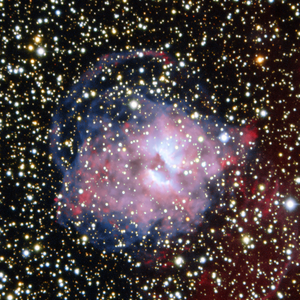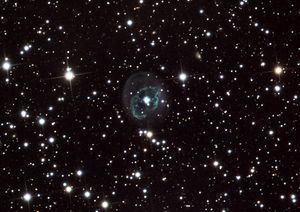سديم كوكبي

السديم الكوكبي planetary nebula، يُختصر PN أو الجمع PNe، هو نوع من السدم الإشعاعية يتألف من غلاف متوهج موسع من الغاز المؤين المبنعث من النجوم العملاقة الحمراء في مراحل متأخرة من حياتها.[2]
يمكن القول إن مصطلح "سديم الكواكب" هو تسمية خاطئة لأنه لا علاقة لها بالكواكب أو الكواكب الخارجية. ومن المرجح أن أصول المصطلح مشتقة من الشكل المستدير الشبيه للكوكب لتلك السدم كما تم رصدها بواسطة الفلكيين في عصر التلسكوبات المبكرة، وعلى الرغم من كونه مصطلح غير صحيح، إلا أنه لا يزال مستخدم من قبل الفلكيين اليوم. ومن المحتمل أن أول استخدام للمصطلح كان في ثمانينيات القرن الثامن عشر بواسطة الفلكي الإنگليزي وليام هرشل الذي وصف هذه السدم كواكب متدمة؛ إلا أنه في يناير 1779، قام الفلكي الفرنسي أنطوان داركييه دو پليپوا بوصف عمليات رصده للسديم المستدير، "..قاتمة للغاية ولكنه واضح تماماً. إنه كبير مثل كوكب المشتري ويبدو ككوكب يتلاشى."[3][4][5]
تتكون جميع السدم الكوكبية في نهاية عمر النجوم متوسطة كتلة. وهي ظاهرة قصيرة نسبياً، ربما تستمر لبضعة عشرات من آلاف السنين، مقارنة بالمراحل الأطول نسبياً لتطور النجوم.[6]. بمجرد أن يتبدد الغلاف الجوي للعملاق الأحمر بالكامل، يقوم الإشعاع الفوق بنفسجي النشط من القلب المضيء المكشوف والمسمى نواة السدم الكوكبية (PNN) بتأيين المادة التي يتم طردها.[2] بعدها يُنشط الضوء غلاف الغاز الغامض حول النجم المركزي، مما يجعله يبدو كسديم كوكبي ساطع اللون.
من المرجح أن السدم الكوكبية تلعب دوراً حاسماً في التطور الكيمائي لمجرة درب التبانة بطرح العناصر إلى وسط بين الكواكب من النجوم حيث تتشكل تلك العناصر. رُصدت السدم الكوكبية في المجرات الأكثر بعداً، مما أثمر عن معلومات مفيدة حول وفرة المواد الكيميائية.
بدءاً من التسعينيات، أظهرت صور تلسكوب الفضاء هبل أن الكثير من السدم الكوكبية تتمتع بمراحل تشكل معقدة للغاية ومتنوعة. خمس السدم الكوكبية تقريباً كروية الشكل، ولكن معظمها غير متناظرة كروياً. الآليات التي تنتج مثل هذا التنوع الواسع من الأشكال والميزات لم تُفهم جيداً بعد، ولكن النجوم المركزية الثنائية، الرياح النجمية والمجالات المغناطيسية قد تلعب دوراً.
عمليات الرصد


الاكتشاف
المصطلح
الطيف
النجوم المركزية
عمليات الرصد الحديثة
الأصول
العمر
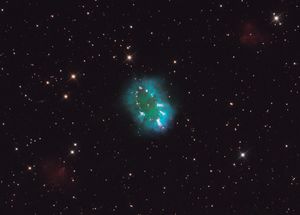
دورها في تطور المجرات
الخصائص
الخصائص الفيزيائية

Credit: STScI/AURA
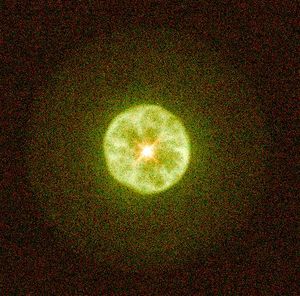
العدد والانتشار
المورفولوجيا
تجمعها في مجموعات
موضوعات حالية حول دراسات السدم الكوكبية

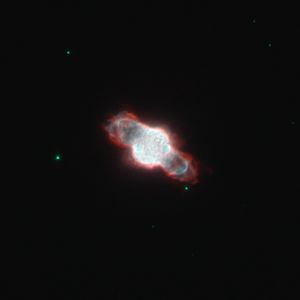
انظر أيضاً
- عملاق مقارب
- سلم المسافات الكونية
- Fast Low-Ionization Emission Region
- قائمة الأسدمة الكوكبية
- بقايا مستعر
- النجم PG 1159 (predegenerates)
- سديم كوكبي أولي
- بقايا مستعر أعظم
- قزم أبيض
المصادر
- ^ Miszalski et al. 2011
- ^ أ ب Frankowski & Soker 2009, pp. 654–8
- ^ Darquier, A. (1777). Observations astronomiques, faites à Toulouse (Astronomical observations, made in Toulouse). Avignon: J. Aubert; (and Paris: Laporte, etc.).
- ^ Olson, Don; Caglieris, Giovanni Maria (June 2017). "Who Discovered the Ring Nebula?". Sky & Telescope. pp. 32–37.
- ^ Wolfgang Steinicke. "Antoine Darquier de Pellepoix". Retrieved 9 June 2018.
- ^ تتكون السدم الكوكبية بعد مرحلة العملاق الأحمر، عندما تزال معظم الطبقات الخارجية للنجم بواسطة الرياح النجمية القوميةFrew & Parker 2010, pp. 129–148
- ^ "A Planetary Nebula Divided". Retrieved 21 December 2015.
- ^ "Hubble Offers a Dazzling Necklace". Picture of the Week. ESA/Hubble. Retrieved 18 August 2011.
- ^ "Cosmic Sprinklers Explained". ESO Press Release. Retrieved 13 February 2013.
المراجع
- Aller, Lawrence H.; Hyung, Siek (2003), "Historical Remarks on the Spectroscopic Analysis of Planetary Nebulae (invited review)", in Kwok, Sun; Dopita, Michael; Sutherland, Ralph, Planetary Nebulae: Their Evolution and Role in the Universe, Proceedings of the 209th Symposium of the International Astronomical Union held at Canberra, Australia, 19-23 November, 2001, 209, Astronomical Society of the Pacific, p. 15, Bibcode: 2003IAUS..209...15A
- Allison, Mark (2006), Star clusters and how to observe them, Birkhäuser, pp. 56–8, ISBN 978-1-84628-190-7
- Bowen, I. S. (October 1927), "The Origin of the Chief Nebular Lines", Publications of the Astronomical Society of the Pacific 39: 295–7, doi:, Bibcode: 1927PASP...39..295B
- Frankowski, Adam; Soker, Noam (November 2009), "Very late thermal pulses influenced by accretion in planetary nebulae", New Astronomy 14 (8): 654–8, doi:, Bibcode: 2009NewA...14..654F, "A planetary nebula (PN) is an expanding ionized circumstellar cloud that was ejected during the asymptotic giant branch (AGB) phase of the stellar progenitor."
- Frew, David J.; Parker, Quentin A. (May 2010), "Planetary Nebulae: Observational Properties, Mimics and Diagnostics", Publications of the Astronomical Society of Australia 27 (2): 129–148, doi:, Bibcode: 2010PASA...27..129F
- Gurzadyan, Grigor A. (1997), The Physics and dynamics of planetary nebulae, Springer, ISBN 978-3-540-60965-0, https://books.google.com/?id=xxVkZBVIZeAC
- Harpaz, Amos (1994), Stellar Evolution, A K Peters, Ltd., ISBN 978-1-56881-012-6, https://books.google.com/?id=kd4VEZv8oo0C&dq
- Hora, Joseph L.; Latter, William B.; Allen, Lori E.; Marengo, Massimo; Deutsch, Lynne K.; Pipher, Judith L. (September 2004), "Infrared Array Camera (IRAC) Observations of Planetary Nebulae", Astrophysical Journal Supplement Series 154 (1): 296–301, doi:, Bibcode: 2004ApJS..154..296H
- Hubble Witnesses the Final Blaze of Glory of Sun-Like Stars, Hubblesite.org - Space Telescope Science Institute (STScI) for NASA, 17 December 1997, http://hubblesite.org/news_release/news/1997-38/91-astronomical, retrieved on 10 June 2018
- Huggins, W.; Miller, W. A. (1864), "On the Spectra of some of the Nebulae", Philosophical Transactions of the Royal Society of London 154: 437–44, doi:, Bibcode: 1864RSPT..154..437H
- Jacoby, George. H.; Ferland, Gary. J.; Korista, Kirk T. (2001), "The Planetary Nebula A39: An Observational Benchmark for Numerical Modeling of Photoionized Plasmas", The Astrophysical Journal 560 (1): 272–86, doi:, Bibcode: 2001ApJ...560..272J, http://uknowledge.uky.edu/cgi/viewcontent.cgi?article=1104&context=physastron_facpub
- Jordan, S.; Werner, K.; O'Toole, S. J. (March 2005), "Discovery of magnetic fields in central stars of planetary nebulae", Astronomy & Astrophysics 432 (1): 273–9, doi:, Bibcode: 2005A&A...432..273J
- Kiss, L. L.; Szabó, Gy. M.; Balog, Z.; Parker, Q. A.; Frew, D. J. (November 2008), "AAOmega radial velocities rule out current membership of the planetary nebula NGC 2438 in the open cluster M46", Monthly Notices of the Royal Astronomical Society 391 (1): 399–404, doi:, Bibcode: 2008MNRAS.391..399K
- Krause, Arthur (1961), Astronomy, Oliver and Boyd, p. 187, https://books.google.com/?id=gDSsAAAAIAAJ
- Kwok, Sun (2000), The origin and evolution of planetary nebulae, Cambridge University Press, ISBN 0-521-62313-8, https://books.google.com/?id=7NfqpZxO_o0C (Chapter 1 can be downloaded here.)
- Kwok, Sun (June 2005), "Planetary Nebulae: New Challenges in the 21st Century", Journal of the Korean Astronomical Society 38 (2): 271–8, doi:, Bibcode: 2005JKAS...38..271K
- Kwok, Sun; Su, Kate Y. L. (December 2005), "Discovery of Multiple Coaxial Rings in the Quadrupolar Planetary Nebula NGC 6881", The Astrophysical Journal 635 (1): L49–52, doi:, Bibcode: 2005ApJ...635L..49K, "We report the discovery of multiple two-dimensional rings in the quadrupolar planetary nebula NGC 6881. As many as four pairs of rings are seen in the bipolar lobes, and three rings are seen in the central torus. While the rings in the lobes have the same axis as one pair of the bipolar lobes, the inner rings are aligned with the other pair. The two pairs of bipolar lobes are likely to be carved out by two separate high-velocity outflows from the circumstellar material left over from the asymptotic giant branch (AGB) wind. The two-dimensional rings could be the results of dynamical instabilities or the consequence of a fast outflow interacting with remnants of discrete AGB circumstellar shells."
- Kwok, Sun; Koning, Nico; Huang, Hsiu-Hui; Churchwell, Edward (2006), Barlow, M. J.; Méndez, R. H., eds., "Planetary nebulae in the GLIMPSE survey", Proceedings of the International Astronomical Union, Symposium #234, Planetary Nebulae in our Galaxy and Beyond (Cambridge: Cambridge University Press) 2 (S234): 445–6, doi:, Bibcode: 2006IAUS..234..445K, "Planetary nebulae (PNs) have high dust content and radiate strongly in the infrared. For young PNs, the dust component accounts for ∼1/3 of the total energy output of the nebulae (Zhang & Kwok 1991). The typical color temperatures of PNs are between 100 and 200 K, and at λ >5 μm, dust begins to dominate over bound-free emission from the ionized component. Although PNs are traditionally discovered through examination of photographic plates or Hα surveys, PNs can also be identified in infrared surveys by searching for red objects with a rising spectrum between 4–10 μm."
- Liu, X.-W.; Storey, P. J.; Barlow, M. J.; Danziger, I. J.; Cohen, M.; Bryce, M. (March 2000), "NGC 6153: a super–metal–rich planetary nebula?", Monthly Notices of the Royal Astronomical Society 312 (3): 585–628, doi:, Bibcode: 2000MNRAS.312..585L
- Maciel, W. J.; Costa, R. D. D.; Idiart, T. E. P. (October 2009), "Planetary nebulae and the chemical evolution of the Magellanic Clouds", Revista Mexicana de Astronomía y Astrofísica 45: 127–37, Bibcode: 2009RMxAA..45..127M, "These objects are produced by low and intermediate mass stars, with main sequence masses roughly between 0.8 and 8 M⊙, and present a reasonably large age and metallicity spread."
- Majaess, D. J.; Turner, D.; Lane, D. (December 2007), "In Search of Possible Associations between Planetary Nebulae and Open Clusters", Publications of the Astronomical Society of the Pacific 119 (862): 1349–60, doi:, Bibcode: 2007PASP..119.1349M
- Marochnik, L.S.; Shukurov, Anwar; Yastrzhembsky, Igor (1996), "Chapter 19: Chemical abundances", The Milky Way galaxy, Taylor & Francis, pp. 6–10, ISBN 978-2-88124-931-0, https://books.google.com/?id=uRgWHDGpKZIC
- Mermilliod, J.-C.; Clariá, J. J.; Andersen, J.; Piatti, A. E.; Mayor, M. (August 2001), "Red giants in open clusters. IX. NGC 2324, 2818, 3960 and 6259", Astronomy and Astrophysics 375 (1): 30–9, doi:, Bibcode: 2001A&A...375...30M
- Miszalski, B.; Jones, D.; Rodríguez-Gil, P.; Boffin, H. M. J.; Corradi, R. L. M.; Santander-García, M. (2011), "Discovery of close binary central stars in the planetary nebulae NGC 6326 and NGC 6778", Astronomy and Astrophysics 531: A158, doi:, Bibcode: 2011A&A...531A.158M
- Moore, S. L. (October 2007), "Observing the Cat's Eye Nebula", Journal of the British Astronomical Association 117 (5): 279–80, Bibcode: 2007JBAA..117R.279M
- Morris, M. (1990), "Bipolar asymmetry in the mass outflows of stars in transition", in Mennessier, M.O., From Miras to planetary nebulae: which path for stellar evolution?, Montpellier, France, September 4–7, 1989 IAP astrophysics meeting: Atlantica Séguier Frontières, pp. 526–30, ISBN 978-2-86332-077-8, https://books.google.com/?id=qTZld_-Y5qYC
- Osterbrock, Donald E.; Ferland, G. J. (2005), Ferland, G. J., ed., Astrophysics of gaseous nebulae and active galactic nuclei, University Science Books, ISBN 978-1-891389-34-4
- Parker, Quentin A.; Acker, A.; Frew, D. J.; Hartley, M.; Peyaud, A. E. J.; Ochsenbein, F.; Phillipps, S.; Russeil, D.; et al. (November 2006), "The Macquarie/AAO/Strasbourg Hα Planetary Nebula Catalogue: MASH", Monthly Notices of the Royal Astronomical Society 373 (1): 79–94, doi:, Bibcode: 2006MNRAS.373...79P
- Parker, Quentin A.; Frew, David J.; Miszalski, B.; Kovacevic, Anna V.; Frinchaboy, Peter.; Dobbie, Paul D.; Köppen, J. (May 2011), "PHR 1315–6555: A bipolar planetary nebula in the compact Hyades-age open cluster ESO 96-SC04", Monthly Notices of the Royal Astronomical Society 413 (3): 1835–1844, doi:, Bibcode: 2011MNRAS.413.1835P
- Reed, Darren S.; Balick, Bruce; Hajian, Arsen R.; Klayton, Tracy L.; Giovanardi, Stefano; Casertano, Stefano; Panagia, Nino; Terzian, Yervant (November 1999), "Hubble Space Telescope Measurements of the Expansion of NGC 6543: Parallax Distance and Nebular Evolution", Astronomical Journal 118 (5): 2430–41, doi:, Bibcode: 1999AJ....118.2430R
- Soker, Noam (February 2002), "Why every bipolar planetary nebula is 'unique'", Monthly Notices of the Royal Astronomical Society 330 (2): 481–6, doi:, Bibcode: 2002MNRAS.330..481S
- The first detection of magnetic fields in the central stars of four planetary nebulae, SpaceDaily Express, January 6, 2005, http://www.spacedaily.com/news/stellar-chemistry-05a.html, retrieved on October 18, 2009, "Source: Journal Astronomy & Astrophysics"
- Rees, B.; Zijlstra, A.A. (July 2013), "Alignment of the Angular Momentum Vectors of Planetary Nebulae in the Galactic Bulge", Monthly Notices of the Royal Astronomical Society 435 (2): 975–991, doi:, Bibcode: 2013MNRAS.435..975R
- Planetary Nebulae, SEDS, September 9, 2013, http://messier.seds.org/planetar.html, retrieved on 2013-11-10
قراءات إضافية
- Iliadis, Christian (2007), Nuclear physics of stars. Physics textbook, Wiley-VCH, pp. 18, 439–42, ISBN 978-3-527-40602-9
- Renzini, A. (1987), S. Torres-Peimbert, ed., "Thermal pulses and the formation of planetary nebula shells", Proceedings of the 131st symposium of the IAU 131: 391–400, Bibcode: 1989IAUS..131..391R
وصلات خارجية
- Entry in the Encyclopedia of Astrobiology, Astronomy, and Spaceflight
- Press release on recent observations of the Cat's Eye Nebula
- Planetary Nebulae, SEDS Messier Pages
- The first detection of magnetic fields in the central stars of four planetary nebulae
- Planetary Nebulae—Information and amateur observations
- Planetary nebula on arxiv.org

